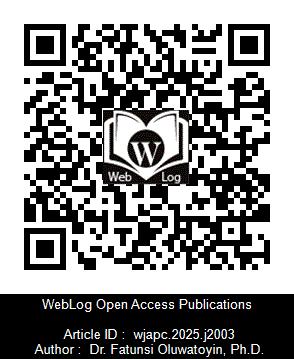
ARTICLE TYPE : RESEARCH ARTICLE
Published on : 20 Oct 2025, Volume - 1
Journal Title : WebLog Journal of Analytical and Pharmaceutical Chemistry | WebLog J Anal Pharm Chem
Source URL: ![]() https://weblogoa.com/articles/wjapc.2025.j2003
https://weblogoa.com/articles/wjapc.2025.j2003
Permanent Identifier (DOI) :  https://doi.org/10.5281/zenodo.17445578
https://doi.org/10.5281/zenodo.17445578
Iodometry and UV Spectrophotometry Determination of Iodine in Some Selected Salt Samples and Freshly Harvested Fish Samples
Abstract
Iodine is a chemical element with the symbol I and atomic number 53. It is a micro nutrient required for proper functioning of the vertebrate endocrine system and plays similar roles in numerous other organisms. The recommended daily intake by WHO-UNICEF is between 90 mg/kg to 250 mg/kg in adults. The aim of the work is to determine the Iodine concentration in selected freshly harvested fish species namely Sole fish (Solea Solea), White Catfish (Ameiurus Catus), Croaker fish (Scianidae) and Red Snapper fish (Lutjanus Campechanus), and six commercial edible salts in Nigeria using two techniques which are UV/ Vis spectrophotometry and Iodometry. The spectroscopic method is based on the reaction of iodate (in acidic medium) and iodide to form iodine and an aqueous matrix was used. For the salt analysis, the analytical signal was measured at 588 nm using the UV-Visible Spectrophotometer. The result of the Visible spectrophotometric for Iodine concentration gave a result in the range of (38.16 to 1189.69) mg/kg while the Iodometric titration gave a result in the range (5.36 - 29.17) mg/kg. The analytical curve was linear in the range of 10-60 mg/L (10-60 mg/ kg) with a correlation coefficient of 0.9912 which shows that the data fits into the model. Comparing this technique with the titration reference method in the six commercial table salts, a significant difference was observed applying paired t-test at 95% confidence interval. The proposed method is a simple, economic and a reliable alternative for iodine species determination of salt. For the fish analysis, alkaline based ashing was used for the sample preparation. The result obtained from the UV/VIS spectrophotometry shows the iodine concentration to be in the range of 200.7 mg/kg to 517 mg/kg while the Iodometry result shows the iodine concentration to be in the range of 85.90 mg/ kg to 427.59 mg/kg. a paired t-test was used to evaluate the significant difference between the two methods and no significant difference was observed at 95% confidence level. It therefore follows that the two methods can be used for analyzing iodine content in fish samples. Furthermore, the result obtained shows that the fish species are good sources of iodine for man.
Keywords: Iodine; Iodometry; Ultra-Violet Spectrometry (UV Spec); Fish; Salt
Citation
Fatunsin O. T, Dosunmu O. M, Fasanya F. O. Iodometry and UV Spectrophotometry Determination of Iodine in Some Selected Salt Samples and Freshly Harvested Fish Samples. WebLog J Anal Pharm Chem. wjapc.2025.j2003. https://doi.org/10.5281/zenodo.17445578